Gigabyte GA-Z170X-GAMING 7 Manual

GA-Z170X-Gaming 7
User's Manual
Rev. 1001
12ME-Z17XGE7-1001R
For more product details, please visit GIGABYTE's website.
To reduce the impacts on global warming, the packaging materials of this product are recyclable and reusable. GIGABYTE works with you to protect the environment.
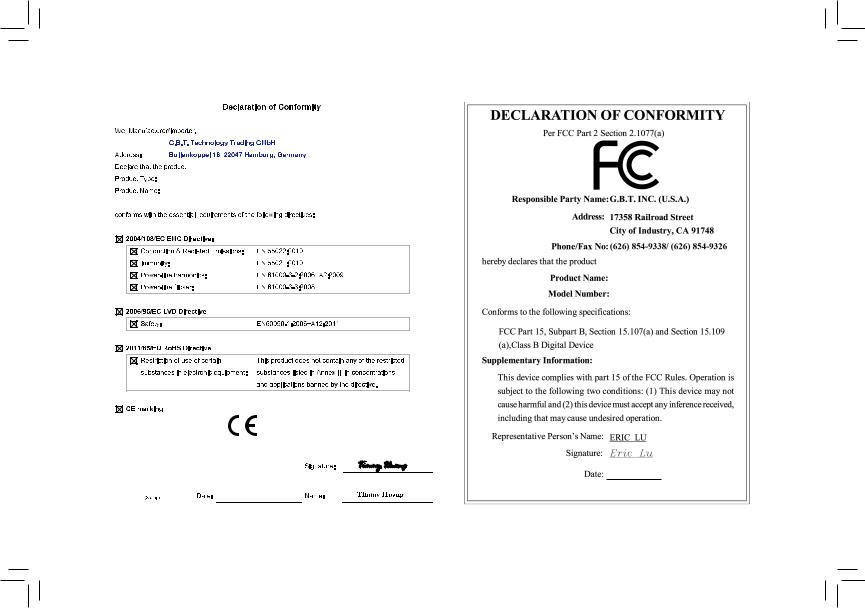
Motherboard
GA-Z170X-Gaming 7
Jul. 24, 2015
Motherboard
GA-Z170X-Gaming 7
Jul. 24, 2015

Copyright
© 2015 GIGA-BYTE TECHNOLOGY CO., LTD. All rights reserved.
The trademarks mentioned in this manual are legally registered to their respective owners.
Disclaimer
Information in this manual is protected by copyright laws and is the property of GIGABYTE.
Changes to the specifications and features in this manual may be made by GIGABYTE without prior notice.
No part of this manual may be reproduced, copied, translated, transmitted, or published in any form or by any means without GIGABYTE's prior written permission.
Documentation Classifications
In order to assist in the use of this product, GIGABYTE provides the following types of
documentations:
For quick set-up of the product, read the Quick Installation Guide included with the product.For detailed product information, carefully read the User's Manual.
For product-related information, check on our website at: http://www.gigabyte.com
Identifying Your Motherboard Revision
The revision number on your motherboard looks like this: "REV: X.X." For example, "REV: 1.0" means the revision of the motherboard is 1.0. Check your motherboard revision before updating motherboard BIOS, drivers, or when looking for technical information.
Example:

Table of Contents
Box Contents.................................................................................................................... |
|
|
6 |
Optional Items.................................................................................................................. |
|
|
6 |
GA-Z170X-Gaming 7 Motherboard Layout...................................................................... |
7 |
||
Chapter 1 Hardware Installation...................................................................................... |
9 |
||
1-1 |
Installation Precautions..................................................................................... |
9 |
|
1-2 |
Product Specifications.................................................................................... |
10 |
|
1-3 |
Installing the CPU and CPU Cooler................................................................ |
14 |
|
1-3-1 |
Installing the CPU................................................................................................... |
14 |
|
1-3-2 Installing the CPU Cooler........................................................................................ |
16 |
||
1-4 |
Installing the Memory...................................................................................... |
17 |
|
1-4-1 Dual Channel Memory Configuration...................................................................... |
17 |
||
1-4-2 |
Installing a Memory................................................................................................. |
18 |
|
1-5 |
Installing an Expansion Card.......................................................................... |
19 |
|
1-6 |
Setting up AMD CrossFire™/NVIDIA® SLI™ Configuration............................... |
20 |
|
1-7 |
Back Panel Connectors.................................................................................. |
21 |
|
1-8 |
Onboard Buttons and Switches...................................................................... |
23 |
|
1-9 |
Changing the Operational Amplifier................................................................ |
25 |
|
1-10 |
Internal Connectors........................................................................................ |
26 |
|
Chapter 2 BIOS Setup................................................................................................... |
39 |
||
2-1 |
Startup Screen................................................................................................ |
40 |
|
2-2 |
The Main Menu............................................................................................... |
41 |
|
2-3 |
M.I.T................................................................................................................ |
43 |
|
2-4 |
System Information......................................................................................... |
56 |
|
2-5 |
BIOS Features................................................................................................ |
57 |
|
2-6 |
Peripherals...................................................................................................... |
60 |
|
2-7 |
Chipset............................................................................................................ |
63 |
|
2-8 |
Power Management........................................................................................ |
64 |
|
2-9 |
Save & Exit..................................................................................................... |
66 |
|
Chapter 3 Configuring a RAID Set................................................................................ |
67 |
||
3-1 |
Configuring SATA Controllers......................................................................... |
67 |
|
3-2 |
Installing the SATA RAID/AHCI Driver and Operating System....................... |
79 |
|
Chapter 4 Drivers Installation........................................................................................ |
83 |
||
4-1 |
Drivers & Software.......................................................................................... |
83 |
|
- 4 -

4-2 |
Application Software....................................................................................... |
84 |
4-3 |
Information...................................................................................................... |
84 |
Chapter 5 Unique Features........................................................................................... |
85 |
||
5-1 |
BIOS Update Utilities...................................................................................... |
85 |
|
|
5-1-1 |
Updating the BIOS with the Q-Flash Utility............................................................. |
85 |
|
5-1-2 |
Updating the BIOS with the @BIOS Utility.............................................................. |
88 |
5-2 |
APP Center..................................................................................................... |
89 |
|
|
5-2-1 |
EasyTune................................................................................................................ |
90 |
|
5-2-2 |
System Information Viewer..................................................................................... |
91 |
|
5-2-3 |
Fast Boot................................................................................................................. |
92 |
|
5-2-4 |
Smart TimeLock...................................................................................................... |
93 |
|
5-2-5 |
USB Blocker............................................................................................................ |
94 |
|
5-2-6 |
Smart Keyboard...................................................................................................... |
95 |
|
5-2-7 |
Smart Backup.......................................................................................................... |
96 |
|
5-2-8 |
Ambient LED........................................................................................................... |
98 |
|
5-2-9 |
3D OSD................................................................................................................... |
99 |
|
5-2-10 |
Cloud Station......................................................................................................... |
100 |
|
5-2-11 |
AutoGreen............................................................................................................. |
105 |
|
5-2-12 |
Easy RAID............................................................................................................. |
106 |
5-3 |
Smart Switch................................................................................................. |
109 |
|
Chapter 6 Appendix..................................................................................................... |
|
111 |
|
6-1 |
Qualcomm® Atheros Killer Network Manager |
................................................111 |
|
6-2 |
Configuring Audio Input and Output.............................................................. |
112 |
|
|
6-2-1 |
Configuring 2/5.1-Channel Audio.......................................................................... |
112 |
|
6-2-2 |
Creative Software Suite........................................................................................ |
112 |
|
6-2-3 |
Configuring S/PDIF Out........................................................................................ |
116 |
|
6-2-4 |
Configuring Audio Recording................................................................................ |
117 |
|
6-2-5 Using the Sound Recorder.................................................................................... |
119 |
|
6-3 |
Troubleshooting............................................................................................ |
120 |
|
|
6-3-1 |
Frequently Asked Questions ................................................................................ |
120 |
|
6-3-2 |
Troubleshooting Procedure................................................................................... |
121 |
6-4 |
Debug LED Codes........................................................................................ |
123 |
|
Regulatory Statements............................................................................................ |
127 |
||
Contact Us............................................................................................................... |
|
131 |
|
- 5 -

Box Contents
55 GA-Z170X-Gaming 7 motherboard
55 Motherboard driver disk
55 User's Manual
55 Quick Installation Guide
55 Four SATA cables
55 I/O Shield
55 One 2-Way SLI bridge connector
55 One G Connector
55 One pack of back I/O dust covers
The box contents above are for reference only and the actual items shall depend on the product package you obtain. The box contents are subject to change without notice.
Optional Items
2-port USB 2.0 bracket (Part No. 12CR1-1UB030-6*R)eSATA bracket (Part No. 12CF1-3SATPW-4*R)
3.5" Front Panel with 2 USB 3.0/2.0 ports (Part No. 12CR1-FPX582-2*R)HDMI-to-DVI adapter (Part No. 12CT2-HDMI01-1*R)
COM port cable (Part No. 12CF1-1CM001-3*R)
- 6 -
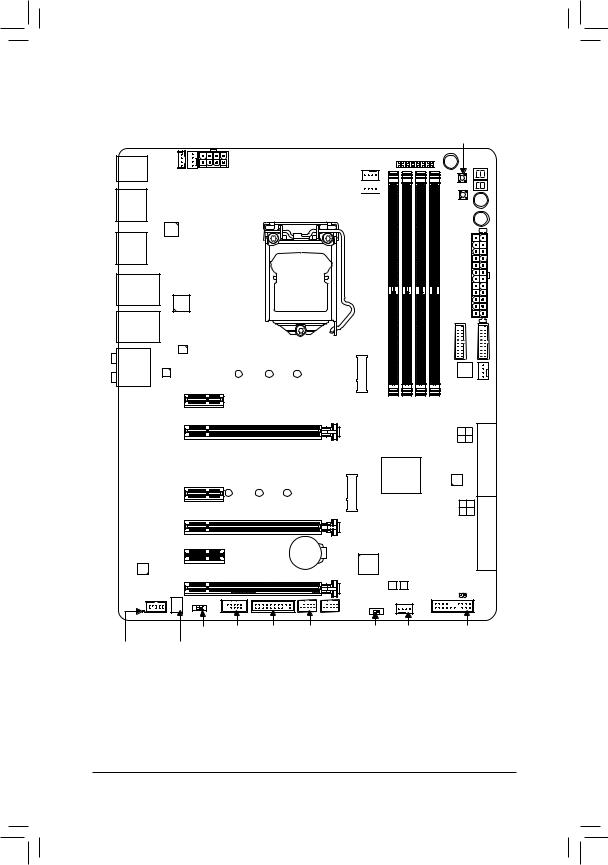
GA-Z170X-Gaming 7 Motherboard Layout
KB_MS_USB30
DP_HDMI
R_USB30
ATX_12V_2X4
SYS_FAN1
LED_IO
LGA1151
MegaChips
MCDP2800
CPU_FAN
CPU_OPT


RST_SW
PW_SW
Debug LED (Note)
CMOS_SW |
ECO |
|
|
|
OC |
|
ATX |
LAN2
TYPEC Intel®
Thunderbolt™ 3
Controller
USB30_LAN1
Qualcomm®
Atheros Killer
E2400 LAN
F USB30 1 |
F USB30 2 |
AUDIO |
Intel® |
|
|
M2D_32G |
|
|
GbE LAN |
80D |
60D |
42D |
3.0 Hub |
|
|
||||
|
|
|
|
DDR44 DDR42 DDR43 DDR41 |
|
|
|
PCIEX1_1 |
|
USBRenesas® FAN3SYS |
|
|
|
|
|
|
PCIEX16
|
PCIEX1_2 |
|
80H |
|
PCIEX8 |
Creative® |
PCIEX1_3 |
|
|
Sound Core 3D |
|
|
PCIEX4 |
F_AUDIO |
|
CAP_SW COMA
System Temperature TI Burr Brown®
Sensor OPA2134
7 6 3 2
GA-Z170X-Gaming 7 |
|
|
SATA3 |
EXPRESS |
||
|
|
|
Intel® Z170 |
ASMedia® |
||
|
M2H_32G |
|
ASM1061 |
|
SATA |
|
|
|
|
|
|||
|
|
|
|
|
||
60H |
42H |
|
|
|
4 0 |
|
|
|
|
|
|
5 1 |
EXPRESS |
|
|
iTE® |
|
|
SATA3 |
|
|
BAT |
Super I/O |
|
|
SATA |
|
|
|
M BIOS B BIOS |
|
|
||
|
|
|
|
|
||
|
|
|
|
CLR_CMOS |
||
|
|
F_USB1 |
|
|
|
|
TPM |
F_USB2 |
|
SB SYS_FAN2 |
F_PANEL |
||
(Note) For debug code information, please refer to Chapter 6.
- 7 -

- 8 -

Chapter 1 Hardware Installation
1-1 Installation Precautions
The motherboard contains numerous delicate electronic circuits and components which can become damaged as a result of electrostatic discharge (ESD). Prior to installation, carefully read the user's manual and follow these procedures:
•• Prior to installation, make sure the chassis is suitable for the motherboard.
•• Prior to installation, do not remove or break motherboard S/N (Serial Number) sticker or warranty sticker provided by your dealer. These stickers are required for warranty validation.
•• Always remove the AC power by unplugging the power cord from the power outlet before installing or removing the motherboard or other hardware components.
•• When connecting hardware components to the internal connectors on the motherboard, make sure they are connected tightly and securely.
•• When handling the motherboard, avoid touching any metal leads or connectors.
•• It is best to wear an electrostatic discharge (ESD) wrist strap when handling electronic components such as a motherboard, CPU or memory. If you do not have an ESD wrist strap, keep your hands dry and first touch a metal object to eliminate static electricity.
•• Prior to installing the motherboard, please have it on top of an antistatic pad or within an electrostatic shielding container.
•• Before connecting or unplugging the power supply cable from the motherboard, make sure the power supply has been turned off.
•• Before turning on the power, make sure the power supply voltage has been set according to the local voltage standard.
•• Before using the product, please verify that all cables and power connectors of your hardware components are connected.
•• To prevent damage to the motherboard, do not allow screws to come in contact with the motherboard circuit or its components.
•• Make sure there are no leftover screws or metal components placed on the motherboard or within the computer casing.
•• Do not place the computer system on an uneven surface.
•• Do not place the computer system in a high-temperature or wet environment.
•• Turning on the computer power during the installation process can lead to damage to system components as well as physical harm to the user.
•• If you are uncertain about any installation steps or have a problem related to the use of the product, please consult a certified computer technician.
•• If you use an adapter, extension power cable, or power strip, ensure to consult with its installation and/or grounding instructions.
- 9 - |
Hardware Installation |

1-2 |
Product Specifications |
|
|
|
|
|
CPU |
Support for Intel® Core™ i7 processors/Intel® Core™ i5 processors/ |
|
|
Intel® Core™ i3 processors/Intel® Pentium® processors/ |
|
|
Intel® Celeron® processors in the LGA1151 package |
|
|
(Go to GIGABYTE's website for the latest CPU support list.) |
|
|
L3 cache varies with CPU |
|
Chipset |
Intel® Z170 Express Chipset |
|
Memory |
4 x DDR4 DIMM sockets supporting up to 64 GB of system memory |
* DuetoaWindows32-bitoperatingsystemlimitation,whenmorethan4GBofphysical memory is installed, the actual memory size displayed will be less than the size of the physical memory installed.
Dual channel memory architecture
Support for DDR4 2133 MHz memory modules
Support for ECC UDIMM 1Rx8/2Rx8 memory modules (operate in non-ECC mode)Support for non-ECC UDIMM 1Rx8/2Rx8/1Rx16 memory modules
Support for Extreme Memory Profile (XMP) memory modules
(Go to GIGABYTE's website for the latest supported memory speeds and memory modules.)
Onboard |
|
Integrated Graphics Processor-Intel® HD Graphics support: |
|
|
Graphics |
|
- |
1 x DisplayPort, supporting a maximum resolution of 4096x2160@24 Hz or |
|
|
|
|
3840x2160@60 Hz |
|
|
|
|
* Support for DisplayPort 1.2 version. |
|
|
Integrated Graphics Processor+MegaChips MCDP2800 chip: |
|||
|
|
- |
1 x HDMI port |
|
|
|
|
* HDMI feature is currently limited. Visit GIGABYTE website for future updates. |
|
|
Maximum shared memory of 512 MB |
|||
Audio |
|
Creative® Sound Core 3D chip |
|
|
|
Support for Sound Blaster Recon3Di |
|||
|
TI Burr Brown® OPA2134 operational amplifier |
|||
|
High Definition Audio |
|||
|
|
2/5.1-channel |
||
|
Support for S/PDIF Out |
|||
LAN |
|
1 x Intel® GbE LAN chip (10/100/1000 Mbit)(LAN1) |
|
|
|
1 x Qualcomm® Atheros Killer E2400 chip (10/100/1000 Mbit) (LAN2) |
|||
|
|
|
* Teaming is not supported. |
|
Expansion Slots |
|
1 x PCI Express x16 slot, running at x16 (PCIEX16) |
|
|
|
|
|
* For optimum performance, if only one PCI Express graphics card is to be installed, |
|
|
|
|
be sure to install it in the PCIEX16 slot. |
|
|
1 x PCI Express x16 slot, running at x8 (PCIEX8) |
|||
|
|
|
* The PCIEX8 slot shares bandwidth with the PCIEX16 slot. When the PCIEX8 slot |
|
|
|
|
is populated, the PCIEX16 slot will operate at up to x8 mode. |
|
|
1 x PCI Express x16 slot, running at x4 (PCIEX4) |
|||
|
|
|
* The PCIEX4 slot shares bandwidth with the M2H_32G connector. The PCIEX4 slot |
|
|
|
|
will become unavailable when an SSD is installed in the M2H_32G connector. |
|
|
3 x PCI Express x1 slots |
|||
|
|
(All of the PCI Express slots conform to PCI Express 3.0 standard.) |
|
|
Multi-Graphics |
|
Support for 3-Way/2-Way AMD CrossFire™ and 2-Way NVIDIA® SLI™ Technology |
||
Technology |
|
|
|
|
|
|
|
|
|
Hardware Installation |
|
|
- 10 - |
|

Storage Interface |
|
Chipset: |
|
|
- 2 x M.2 Socket 3 connectors |
|
|
- 3 x SATA Express connectors |
|
|
- 6 x SATA 6Gb/s connectors (SATA3 0~5) |
|
|
- Support for RAID 0, RAID 1, RAID 5, and RAID 10 |
|
|
* Refer to "1-10 Internal Connectors," for the supported configurations with the M.2, |
|
|
SATA Express, and SATA connectors. |
|
|
ASMedia® ASM1061 chip: |
|
|
- 2 x SATA 6Gb/s connectors (SATA3 6~7), supporting AHCI mode only |
USB |
|
Chipset: |
|
|
- 5 x USB 3.0/2.0 ports on the back panel |
|
|
- 4 x USB 2.0/1.1 ports (available through the internal USB headers) |
|
|
Chipset+Renesas® USB 3.0 Hub: |
|
|
- 4 x USB 3.0/2.0 ports (available through the internal USB headers) |
|
|
Chipset+Intel® Thunderbolt™ 3 Controller: |
|
|
- 1 x USB Type-C™ port on the back panel, with USB 3.1 support |
|
|
- 1 x USB 3.1 port on the back panel |
Internal |
|
1 x 24-pin ATX main power connector |
Connectors |
|
1 x 8-pin ATX 12V power connector |
|
|
2 x M.2 Socket 3 connectors |
|
|
3 x SATA Express connectors |
|
|
8 x SATA 6Gb/s connectors |
|
|
1 x I/O shield audio LED power connector |
|
|
1 x CPU fan header |
|
|
1 x water cooling fan header (CPU_OPT) |
|
|
3 x system fan headers |
|
|
1 x front panel header |
|
|
1 x front panel audio header |
|
|
2 x USB 3.0/2.0 headers |
|
|
2 x USB 2.0/1.1 headers |
|
|
1 x Trusted Platform Module (TPM) header |
|
|
1 x serial port header |
|
|
1 x Clear CMOS jumper |
|
|
1 x power button |
|
|
1 x reset button |
|
|
1 x Clear CMOS button |
|
|
1 x ECO button |
|
|
1 x OC button |
|
|
1 x audio gain control switch |
|
|
Voltage Measurement Points |
|
|
1 x BIOS switch |
- 11 - |
Hardware Installation |

Back Panel |
|
1 x PS/2 keyboard/mouse port |
|
Connectors |
|
1 x DisplayPort |
|
|
1 x HDMI port |
||
|
1 x USB Type-C™ port, with USB 3.1 support |
||
|
1 x USB 3.1 port |
||
|
5 x USB 3.0/2.0 ports |
||
|
2 x RJ-45 ports |
||
|
1 x optical S/PDIF Out connector |
||
|
5 x audio jacks (Center/Subwoofer Speaker Out, Rear Speaker Out, Line In/Mic |
||
|
|
In, Line Out, Headphone) |
|
I/O Controller |
|
iTE® I/O Controller Chip |
|
Hardware |
|
System voltage detection |
|
Monitor |
|
CPU/System/Chipset temperature detection |
|
|
CPU/CPU OPT/System fan speed detection |
||
|
|
CPU/System/Chipset overheating warning |
|
|
CPU/CPU OPT/System fan fail warning |
||
|
CPU/CPU OPT/System fan speed control |
||
|
|
|
* Whether the fan speed control function is supported will depend on the cooler you |
|
|
|
install. |
BIOS |
|
2 x 128 Mbit flash |
|
|
Use of licensed AMI UEFI BIOS |
||
|
Support for DualBIOS™ |
||
|
PnP 1.0a, DMI 2.7, WfM 2.0, SM BIOS 2.7, ACPI 5.0 |
||
Unique Features |
|
Support for APP Center |
|
|
|
|
* Available applications in APP Center may vary by motherboard model. Supported |
|
|
|
functionsofeachapplicationmayalsovarydependingonmotherboardspecifications. |
|
|
- |
3D OSD |
|
|
- |
@BIOS |
|
|
- |
Ambient LED |
|
|
- |
AutoGreen |
|
|
- |
Cloud Station |
|
|
- |
EasyTune |
|
|
- |
Easy RAID |
|
|
- |
Fast Boot |
|
|
- |
Smart TimeLock |
|
|
- |
Smart Keyboard |
|
|
- |
Smart Backup |
|
|
- |
System Information Viewer |
|
|
- |
USB Blocker |
|
|
Support for Q-Flash |
|
|
Support for Smart Switch |
||
|
Support for Xpress Install |
||
Hardware Installation |
- 12 - |

Bundled |
Norton® Internet Security (OEM version) |
|
Software |
Intel® Smart Response Technology |
|
Operating |
Support for Windows 10/8.1/7 |
|
System |
||
|
||
Form Factor |
ATX Form Factor; 30.5cm x 24.4cm |
*GIGABYTE reserves the right to make any changes to the product specifications and product-related information without prior notice.
Please visit GIGABYTE's website for support lists of CPU, memory modules, SSDs, and M.2 devices.
Please visit the Support & Downloads\Utility page on GIGABYTE's website to download the latest version of apps.
- 13 - |
Hardware Installation |

1-3 |
Installing the CPU and CPU Cooler |
|
|
Read the following guidelines before you begin to install the CPU: |
|
|
•• |
Make sure that the motherboard supports the CPU. |
|
|
(Go to GIGABYTE's website for the latest CPU support list.) |
|
•• |
Always turn off the computer and unplug the power cord from the power outlet before installing the |
|
|
CPU to prevent hardware damage. |
|
•• |
Locate the pin one of the CPU. The CPU cannot be inserted if oriented incorrectly. (Or you may |
|
|
locate the notches on both sides of the CPU and alignment keys on the CPU socket.) |
|
•• |
Apply an even and thin layer of thermal grease on the surface of the CPU. |
|
•• |
Do not turn on the computer if the CPU cooler is not installed, otherwise overheating and damage |
|
|
of the CPU may occur. |
|
•• |
Set the CPU host frequency in accordance with the CPU specifications. It is not recommended |
|
|
that the system bus frequency be set beyond hardware specifications since it does not meet the |
|
|
standard requirements for the peripherals. If you wish to set the frequency beyond the standard |
|
|
specifications, please do so according to your hardware specifications including the CPU, graphics |
|
|
card, memory, hard drive, etc. |
1-3-1 Installing the CPU
A. Locate the alignment keys on the motherboard CPU socket and the notches on the CPU.
LGA1151 CPU Socket
Alignment Key |
Alignment Key |
Pin One Corner of the CPU Socket
|
LGA1151 CPU |
Notch |
Notch |
Triangle Pin One Marking on the CPU
Please visit GIGABYTE's website for details on hardware installation.
Hardware Installation |
- 14 - |

B. Follow the steps below to correctly install the CPU into the motherboard CPU socket.
•• Before installing the CPU, make sure to turn off the computer and unplug the power cord from the power outlet to prevent damage to the CPU.
•• To protect the socket contacts, do not remove the protective plastic cover unless the CPU is inserted into the CPU socket. Save the cover properly and replace it if the CPU is removed.
Step 1:
Gently press the CPU socket lever handle down and away from the socket with your finger. Then completely lift the CPU socket lever and the metal load plate/plastic cover will be lifted as well.
Step 3:
Once the CPU is properly inserted, carefully replace the load plate. When replacing the load plate, make sure the front end of the load plate is under the shoulder screw. Then press the CPU socket lever. The protective plastic cover may pop off from the load plate during the process of engaging the lever. Remove the cover. (Save the cover properly and always replace it when the
CPU is not installed.)
Step 2:
Hold the CPU with your thumb and index fingers. Align the CPU pin one marking (triangle) with the pin one corner of the CPU socket (or you may align the CPU notches with the socket alignment keys) and gently insert the CPU into position.
Step 4:
Finally, secure the lever under its retention tab to complete the installation of the CPU.
NOTE:
Hold the CPU socket lever by the handle, not the lever base portion.
- 15 - |
Hardware Installation |
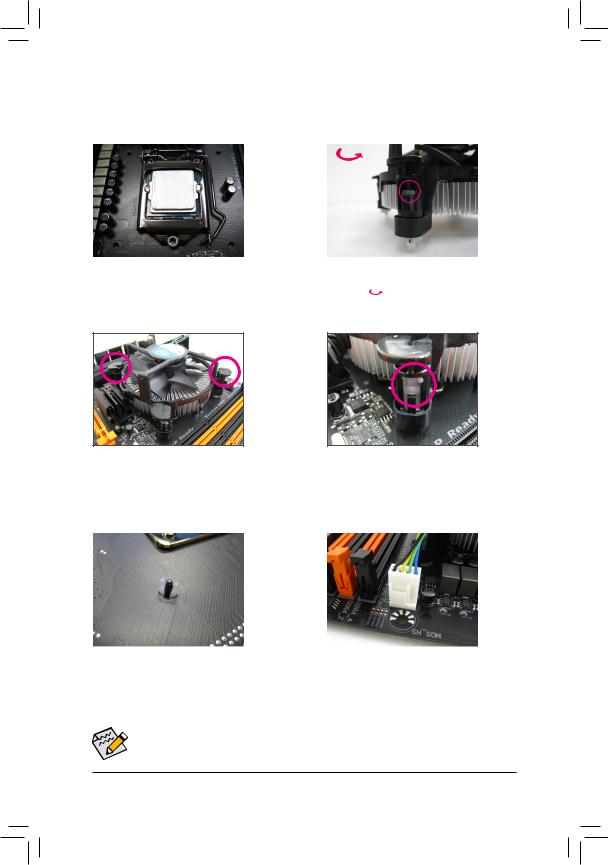
1-3-2 Installing the CPU Cooler
Refer to the steps below to correctly install the CPU cooler on the motherboard. (Actual installation process may differ depending the CPU cooler to be used. Refer to the user's manual for your CPU cooler.)
|
|
|
|
|
|
|
|
Male |
|
|
|
|
|
|
|
|
|
|
|
Direction of |
|
|
|
|
|
Push Pin |
|
|
the Arrow Sign |
|
|
|
|
|
|
|
|
on the Male |
|
|
|
|
|
The Top |
|
|
Push Pin |
|
|
|
|
|
|
|
|
|
|
|
|
|
of Female |
|
|
|
|
|
|
|
|
|
|
|
|
|
|
|
|
|
|
Push Pin |
|
|
|
|
|
|
|
|
Female |
|
|
|
|
|
|
|
||
|
|
|
|
|
|
|
|
Push Pin |
Step 1: |
Step 2: |
|
|
|
|
|
|
|
Apply an even and thin layer of thermal grease on |
Before installing the cooler, note the direction of the |
|||||||
the surface of the installed CPU. |
arrow sign |
on the male push pin. (Turning the |
||||||
push pin along the direction of arrow is to remove the cooler, on the contrary, is to install.)
Step 3: |
Step 4: |
||
Place the cooler atop the CPU, aligning the |
You should hear a "click" when pushing down each |
||
four push pins through the pin holes on the |
push pin. Check that the Male and Female push |
||
motherboard. Push down on the push pins |
pins are joined closely. |
||
diagonally. |
(Refer to your CPU cooler installation manual for |
||
|
|
instructions on installing the cooler.) |
|
|
|
|
|
|
|
|
|
Step 5: |
Step 6: |
After the installation, check the back of the |
Finally, attach the power connector of the CPU |
motherboard. If the push pin is inserted as the |
cooler to the CPU fan header (CPU_FAN) on the |
picture above shows, the installation is complete. |
motherboard. |
 Use extreme care when removing the CPU cooler because the thermal grease/tape between the CPU cooler and CPU may adhere to the CPU. Inadequately removing the CPU cooler may damage the CPU.
Use extreme care when removing the CPU cooler because the thermal grease/tape between the CPU cooler and CPU may adhere to the CPU. Inadequately removing the CPU cooler may damage the CPU.
Hardware Installation |
- 16 - |
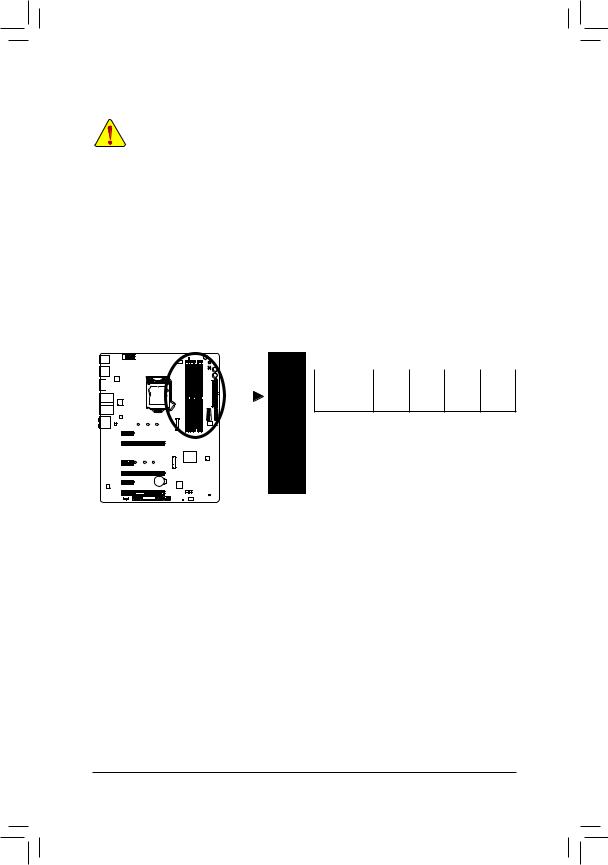
1-4 Installing the Memory
Read the following guidelines before you begin to install the memory:
•• Make sure that the motherboard supports the memory. It is recommended that memory of the same capacity, brand, speed, and chips be used.
(Go to GIGABYTE's website for the latest supported memory speeds and memory modules.)
•• Always turn off the computer and unplug the power cord from the power outlet before installing the memory to prevent hardware damage.
•• Memory modules have a foolproof design. A memory module can be installed in only one direction. If you are unable to insert the memory, switch the direction.
1-4-1 Dual Channel Memory Configuration
This motherboard provides four memory sockets and supports Dual Channel Technology. After the memory is installed, the BIOS will automatically detect the specifications and capacity of the memory. Enabling Dual
Channel memory mode will double the original memory bandwidth.
The four memory sockets are divided into two channels and each channel has two memory sockets as following:
Channel A: DDR4_2, DDR4_4Channel B: DDR4_1, DDR4_3
Dual Channel Memory Configurations Table
|
DDR4_4 |
DDR4_2 |
DDR4_3 |
DDR4_1 |
2 Modules |
- - |
DS/SS |
- - |
DS/SS |
|
DS/SS |
- - |
DS/SS |
- - |
4 Modules |
DS/SS |
DS/SS |
DS/SS |
DS/SS |
(SS=Single-Sided, DS=Double-Sided, "- -"=No Memory)
DDR4_1
DDR4_3
DDR4_2
DDR4_4
Due to CPU limitations, read the following guidelines before installing the memory in Dual Channel mode.
1.Dual Channel mode cannot be enabled if only one memory module is installed.
2.When enabling Dual Channel mode with two or four memory modules, it is recommended that memory of the same capacity, brand, speed, and chips be used and installed in the same colored sockets.
- 17 - |
Hardware Installation |
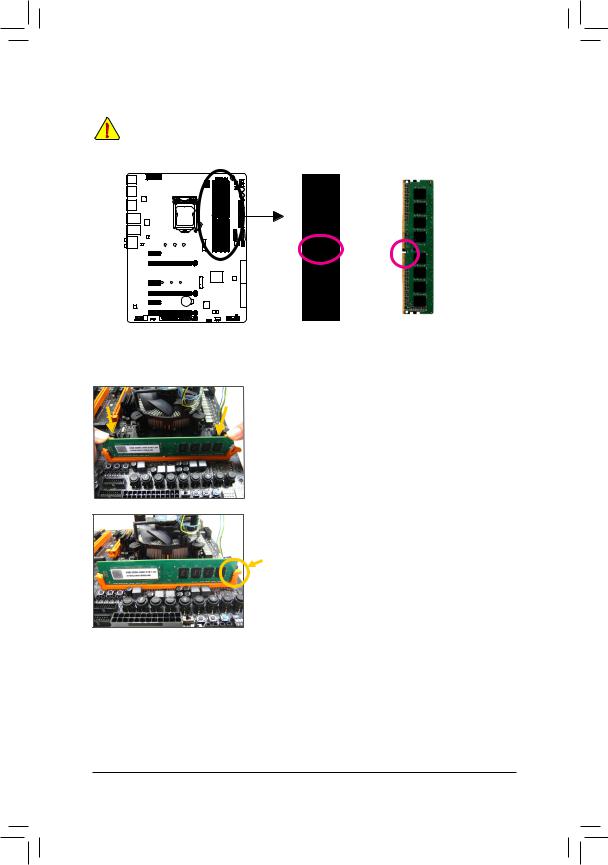
1-4-2 Installing a Memory
Before installing a memory module, make sure to turn off the computer and unplug the power cord from the power outlet to prevent damage to the memory module. DDR4 and DDR3 DIMMs are not compatible to each other or DDR2 DIMMs. Be sure to install DDR4 DIMMs on this motherboard.
Notch
DDR4 DIMM
ADDR4 memory module has a notch, so it can only fit in one direction. Follow the steps below to correctly install your memory modules in the memory sockets.
Step 1:
Note the orientation of the memory module. Spread the retaining clip at the right end of the memory socket. Place the memory module on the socket. As indicated in the picture on the left, place your fingers on the top edge of the memory, push down on the memory and insert it vertically into the memory socket.
Step 2:
The clip at the right end of the socket will snap into place when the memory module is securely inserted.
Hardware Installation |
- 18 - |
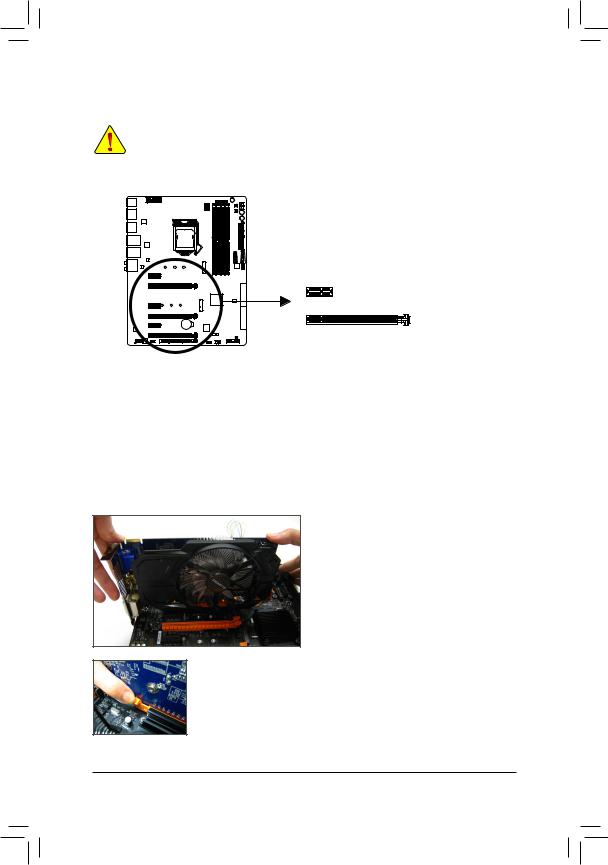
1-5 Installing an Expansion Card
Read the following guidelines before you begin to install an expansion card:
•• Make sure the motherboard supports the expansion card. Carefully read the manual that came with your expansion card.
•• Always turn off the computer and unplug the power cord from the power outlet before installing an expansion card to prevent hardware damage.
PCI Express x1 Slot
PCI Express x16 Slot
Follow the steps below to correctly install your expansion card in the expansion slot.
1.Locate an expansion slot that supports your card. Remove the metal slot cover from the chassis back panel.
2.Align the card with the slot, and press down on the card until it is fully seated in the slot.
3.Make sure the metal contacts on the card are completely inserted into the slot.
4.Secure the card's metal bracket to the chassis back panel with a screw.
5.After installing all expansion cards, replace the chassis cover(s).
6.Turn on your computer. If necessary, go to BIOS Setup to make any required BIOS changes for your expansion card(s).
7.Install the driver provided with the expansion card in your operating system.
Example: Installing and Removing a PCI Express Graphics Card:
•• Installing a Graphics Card:
Gently push down on the top edge of the card until it is fully inserted into the PCI Express slot. Make sure the card is securely seated in the slot and does not rock.
•• Removing the Card:
Gently push back on the lever on the slot and then lift the card straight out from the slot.
- 19 - |
Hardware Installation |
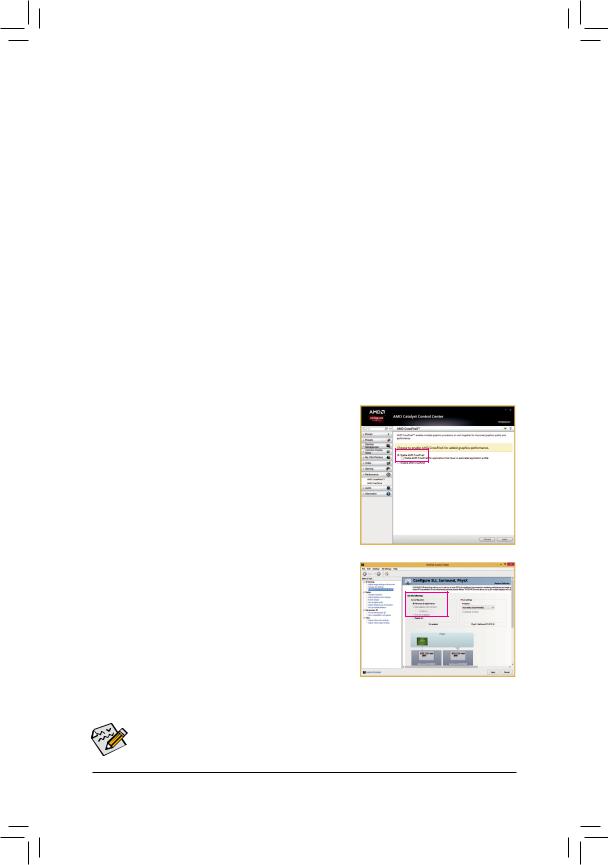
1-6 Setting up AMD CrossFire™/NVIDIA® SLI™ Configuration
A.System Requirements
-- Windows 10/8.1/7 operating system
-- A CrossFire/SLI-supported motherboard with two or more PCI Express x16 slots and correct driver -- CrossFire/SLI-ready graphics cards of identical brand and chip and correct driver
(Current GPUs that support 3-Way CrossFire technology include theATI Radeon™ HD 3800, HD 4800, HD
5800 series, and AMD Radeon™ HD 6800, HD 6900, HD 7800, and HD 7900 series. For the latest GPU support information, please refer to the AMD/NVIDIA® website.)
-- CrossFire(Note)/SLI bridge connectors
-- A power supply with sufficient power is recommended (Refer to the manual of your graphics cards for the power requirement)
B.Connecting the Graphics Cards
Step 1:
Observe the steps in "1-5 Installing an Expansion Card" and install CrossFire/SLI graphics cards on the PCI Express x16 slots.
Step 2:
Insert the CrossFire(Note)/SLI bridge connectors in the CrossFire/SLI gold edge connectors on top of the cards.
Step 3:
Plug the display cable into the graphics card on the PCIEX16 slot.
C. Configuring the Graphics Card Driver
C-1. To Enable CrossFire Function
After installing the graphics card driver in the operating system, go to the AMD Catalyst Control Center. Browse to Performance\ AMD CrossFireX™ and ensure the Enable AMD CrossFireX check box is selected. If your system has more than two CrossFire cards, select the GPU combination you want to use and click Apply. (Available combination options are dependent on the number of graphics cards.)
C-2. To Enable SLI Function
After installing the graphics card driver in the operating system, go to the NVIDIA Control Panel. Browse to the ConfigureSLI,Surround,
Physx screen and ensure Maximize 3D performance is enabled.
(Note) |
The bridge connector(s) may be needed or not depending on your graphics cards. |
Procedure and driver screen for enabling CrossFire/SLI technology may differ by graphics cards and driver version.
RefertothemanualthatcamewithyourgraphicscardsformoreinformationaboutenablingCrossFire/SLItechnology.
Hardware Installation |
- 20 - |
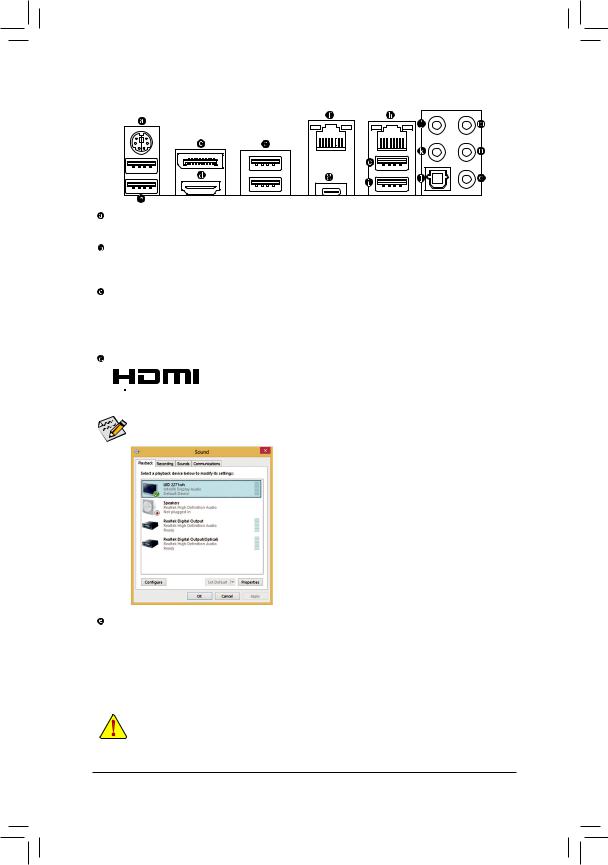
1-7 Back Panel Connectors
PS/2 Keyboard/Mouse Port
Use this port to connect a PS/2 mouse or keyboard.
USB 3.0/2.0 Port
The USB 3.0 port supports the USB 3.0 specification and is compatible to the USB 2.0/1.1 specification.
You can connect a USB DAC to this port or use this port for USB devices.
DisplayPort
DisplayPort delivers high quality digital imaging and audio, supporting bi-directional audio transmission. DisplayPort can support both DPCP and HDCP content protection mechanisms. You can use this port to connect your DisplayPort-supported monitor. The maximum supported resolution is 4096x2160@24 Hz or 3840x2160@60 Hz, but the actual resolutions supported are dependent on the monitor being used.
HDMI Port
 The HDMI port is HDCP compliant and supports Dolby True HD and DTS HD
The HDMI port is HDCP compliant and supports Dolby True HD and DTS HD












 Master Audio formats. It also supports up to 192KHz/24bit 8-channel LPCM audio output. You can use this port to connect your HDMI-supported monitor.
Master Audio formats. It also supports up to 192KHz/24bit 8-channel LPCM audio output. You can use this port to connect your HDMI-supported monitor.
After installing the HDMI/DisplayPort device, make sure to set the default sound playback device to
HDMI/DisplayPort. (The item name may differ depending on your operating system.)
In Windows 8.1, select Apps>Control Panel>Hardware and Sound>Sound>Playback, set Intel(R) DisplayAudio to the default playback device.
USB 3.0/2.0 Port
The USB 3.0 port supports the USB 3.0 specification and is compatible to the USB 2.0/1.1 specification.
Use this port for USB devices.
•• When removing the cable connected to a back panel connector, first remove the cable from your device and then remove it from the motherboard.
•• When removing the cable, pull it straight out from the connector. Do not rock it side to side to prevent an electrical short inside the cable connector.
- 21 - |
Hardware Installation |

RJ-45 LAN Port (LAN2)
The Gigabit Ethernet LAN port provides Internet connection at up to 1 Gbps data rate. The following describes the states of the LAN port LEDs.
Connection/ |
|
|
|
Activity LED |
|
|
|
|
|||||||||||
Speed LED |
|
|
|
|
|
|
|
||||||||||||
|
|
|
|
|
|
|
|
|
|
|
|
|
|
|
State |
Description |
|
State |
Description |
|
|
|
|
|
|
|
|
|
|
|
|
|
|
|
Orange |
1 Gbps data rate |
|
Blinking |
Data transmission or receiving is occurring |
|
|
|
|
|
|
|
|
|
|
|
|
|
|
|
Green |
100 Mbps data rate |
|
Off |
No data transmission or receiving is occurring |
|
|
|
|
|
|
|
|
|
|
|
|||||||||
|
|
|
|
|
|
|
|
|
|
|
|
|
|
|
Off |
10 Mbps data rate |
|
|
|
|
|
|
|
|
|
|
|
|
|
|
|
|
|
|
|
|
|||
|
|
|
|
LAN Port |
|
|
|
||||||||||||
|
|
|
|
|
|
|
|
|
|||||||||||
USB Type-C™ Port
The reversible USB port supports the USB 3.1 specification and is compatible to the USB 3.0/2.0 specification. Use this port for USB devices.
RJ-45 LAN Port (LAN1)
The Gigabit Ethernet LAN port provides Internet connection at up to 1 Gbps data rate. The following describes the states of the LAN port LEDs.
Connection/ |
|
|
|
|
|
|
|
|
Connection/Speed LED: |
Activity LED: |
|
||||||||
Speed LED |
|
|
|
Activity LED |
|
||||||||||||||
|
|
|
|
|
|
|
|
||||||||||||
|
|
|
|
|
|
|
|
|
|
|
|
|
|
|
State |
Description |
|
State |
Description |
|
|
|
|
|
|
|
|
|
|
|
|
|
|
|
Orange |
1 Gbps data rate |
|
Blinking |
Data transmission or receiving is occurring |
|
|
|
|
|
|
|
|
|
|
|
|
|
|
|
Green |
100 Mbps data rate |
|
On |
No data transmission or receiving is occurring |
|
|
|
|
|
|
|
|
|
|
|
|
|
|
|
|||||
|
|
|
|
|
|
|
|
|
|
|
|
|
|
|
Off |
10 Mbps data rate |
|
|
|
|
|
|
|
|
|
|
|
|
|
|
|
|
|
|
|
|
|
||
|
|
|
|
LAN Port |
|
|
|
||||||||||||
|
|
|
|
|
|
|
|
|
|||||||||||
USB 3.1 Port
TheUSB3.1portsupportstheUSB3.1specification andiscompatibletotheUSB3.0/2.0/1.1specification.
Use this port for USB devices.
Line In/Mic In
The line in/Mic in jack. Use this audio jack for line in devices such as optical drive, walkman, microphone, etc.
Line Out
The line out jack. Use this audio jack for a 2-channel speaker. This jack can be used to connect front speakers in a 5.1-channel audio configuration.
Optical S/PDIF Out Connector
This connector provides digital audio out to an external audio system that supports digital optical audio. Before using this feature, ensure that your audio system provides an optical digital audio in connector.
Center/Subwoofer Speaker Out
Use this audio jack to connect center/subwoofer speakers in a 5.1-channel audio configuration.
Rear Speaker Out
Use this audio jack to connect rear speakers in a 5.1-channel audio configuration.
Headphone/Speaker Out
This audio output jack supports audio amplifying function. For better sound quality, it is recommended that you connect your headphone/speaker to this jack.

 Refer to the instructions on setting up a 2/5.1-channel audio configuration in Chapter 6, "Configuring
Refer to the instructions on setting up a 2/5.1-channel audio configuration in Chapter 6, "Configuring
2/5.1-Channel Audio."
Hardware Installation |
- 22 - |
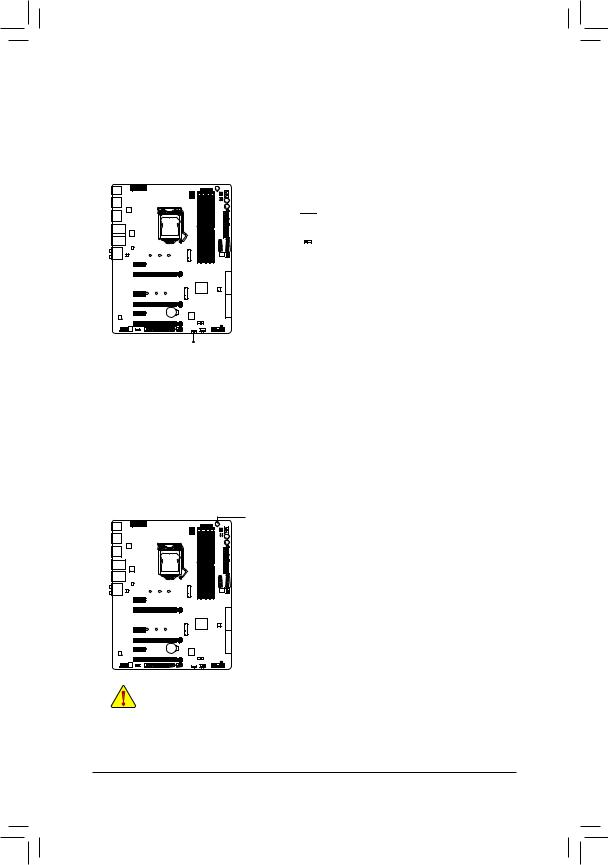
1-8 Onboard Buttons and Switches
BIOS Switch
The SB switch allows enabling or disabling of the Dual BIOS function.
2  1 1: Dual BIOS
1 1: Dual BIOS
2 |
|
1 2: Single BIOS |
|
||
|
SB
Quick Buttons
This motherboard has 3 quick buttons: power button, reset button and clear CMOS button. The power button and reset button allow users to quickly turn on/off or reset the computer in an open-case environment when they want to change hardware components or conduct hardware testing. Use this button to clear the BIOS configuration and reset the CMOS values to factory defaults when needed.
 PW_SW
PW_SW


 RST_SW
RST_SW



 CMOS_SW
CMOS_SW
PW_SW: Power Button
RST_SW: Reset Button
CMOS_SW: Clear CMOS Button
•• Always turn off your computer and unplug the power cord from the power outlet before clearing the CMOS values.
•• NOTE: Do not use the clear CMOS button when the system is on, or the system may shutdown and data loss or damage may occur.
•• Aftersystemrestart,gotoBIOSSetuptoloadfactorydefaults(selectLoadOptimizedDefaults)or manuallyconfiguretheBIOSsettings(refertoChapter2,"BIOSSetup,"forBIOSconfigurations).
- 23 - |
Hardware Installation |
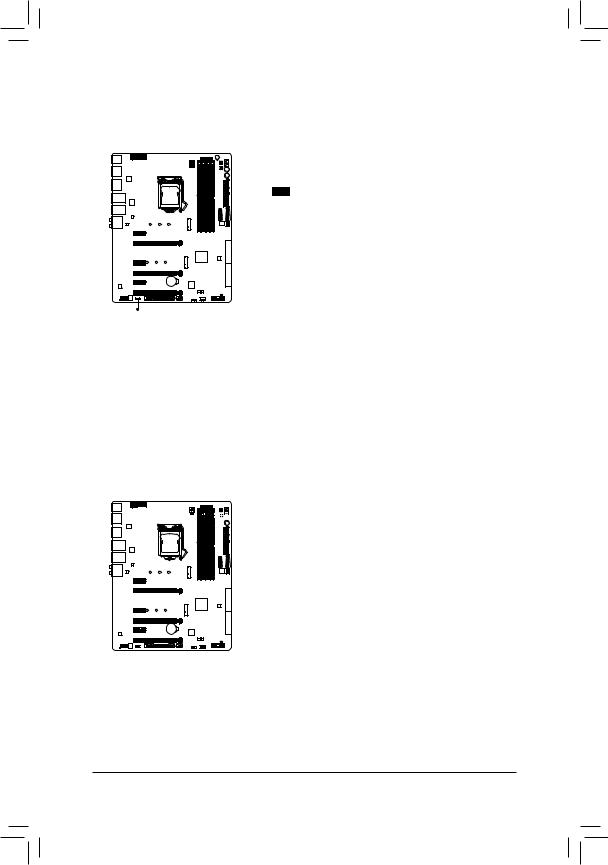
Audio Gain Control Switches
The switch allows for audio gain control for the headphone/speaker out jack on the back panel. Please set it according to your headphone specification (actual effects may vary by the device being used).
2 |
1 |
1: 2.5x (Default) |
|
||
|
|
2: 6x |
CAP_SW
ECO Button and OC Button
GIGABYTE's unique ECO button provides power-saving features by automatically reducing the overall power consumption according to current system load. The OC button helps enthusiasts and overclockers not only get the most performance from their hardware, but also the absolute most enjoyable OC experience.









 ECO
ECO 



 OC
OC
ECO Button:
Press this button to enable this feature.
OC Button:
Press this button to load the most optimized GIGABYTE overclocking configuration for your hardware.
Hardware Installation |
- 24 - |
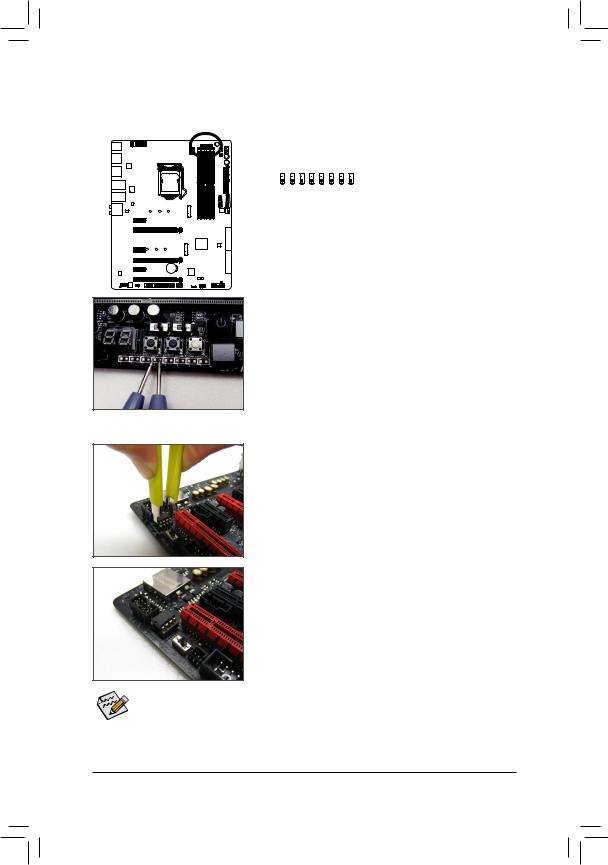
Voltage Measurement Points
Use a multimeter to measure the following motherboard voltages. You can employ following way to measure component voltages.
VCCIO VAXG VDIMM DDRVTT PCHIO VSA VCORE VPP 25V |
|
|
||||||||
Pin No. |
Definition |
|||||||||
|
|
|
|
|
|
|
|
|
1 |
Power |
|
|
|
|
|
|
|
|
|
2 |
GND |
1 1 1 1 1 1 1 1 |
||||||||||
Pin Pin Pin Pin Pin Pin Pin Pin |
|
|
||||||||
Steps:
Connect theredleadofthemultimeter tothepin1(Power)ofavoltage measurement point and the black lead to the pin 2 (ground).
1-9 Changing the Operational Amplifier
Step 1:
Use an IC extractor to carefully grip the IC's sides and extract it from the socket.
Step 2:
Align the notch on your OP chip with the notch on the socket and gently press the chip into the socket until seated.
For purchasing the IC extractor and OP Chip, please contact the local dealer.
- 25 - |
Hardware Installation |
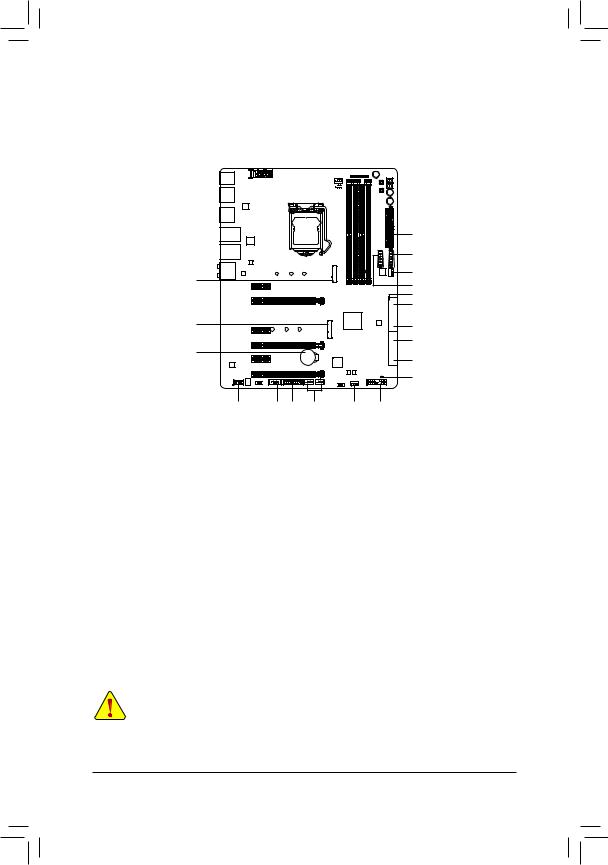
1-10 Internal Connectors
6 |
4 |
1 |
5 |
3 |
|
|
|
|
||||||||
|
|
|
|
|
|
|
|
|
|
|
|
|
|
|
|
|
|
|
|
|
|
|
|
|
|
|
|
|
|
|
|
|
|
|
|
|
|
|
|
|
|
|
|
|
|
|
|
|
|
|
|
2 |
|
|
13 |
|
10 |
4 |
|
13 |
||
|
||
|
9 |
|
|
8 |
|
10 |
7 |
|
17 |
8 |
|
7 |
||
|
||
|
18 |
12 |
16 |
15 |
14 |
4 |
11 |
1) |
ATX_12V_2X4 |
10) |
M2D_32G/M2H_32G |
2) |
ATX |
11) |
F_PANEL |
3) |
CPU_FAN |
12) |
F_AUDIO |
4) |
SYS_FAN1/2/3 |
13) |
F_USB30_1/F_USB30_2 |
5) |
CPU_OPT |
14) |
F_USB1/F_USB2 |
6) |
LED_IO |
15) |
TPM |
7) |
SATA EXPRESS |
16) |
COMA |
8) |
SATA3 0/1/2/3/4/5 |
17) |
BAT |
9) |
SATA3 6/7 |
18) |
CLR_CMOS |
Read the following guidelines before connecting external devices:
•• First make sure your devices are compliant with the connectors you wish to connect.
•• Before installing the devices, be sure to turn off the devices and your computer. Unplug the power cord from the power outlet to prevent damage to the devices.
•• After installing the device and before turning on the computer, make sure the device cable has been securely attached to the connector on the motherboard.
Hardware Installation |
- 26 - |
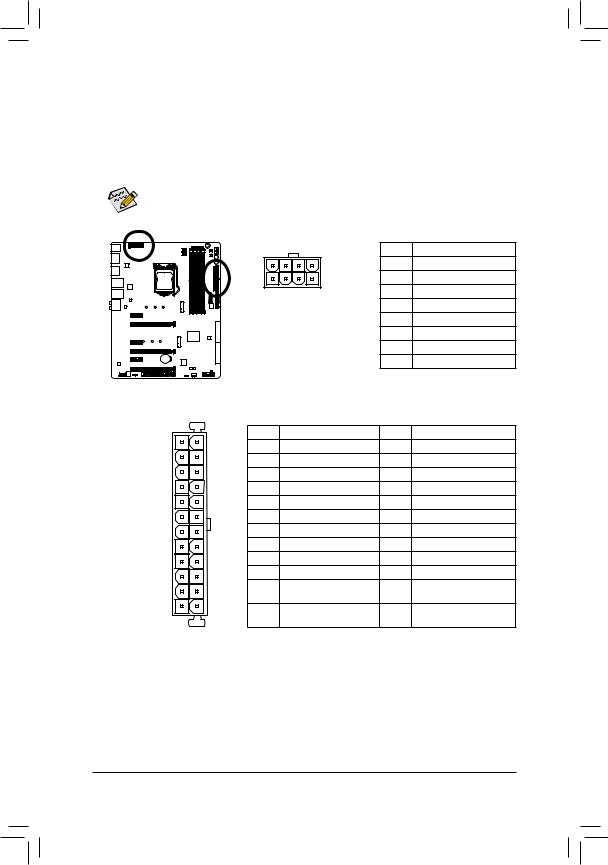
1/2) ATX_12V_2X4/ATX (2x4 12V Power Connector and 2x12 Main Power Connector)
With the use of the power connector, the power supply can supply enough stable power to all the components on the motherboard. Before connecting the power connector, first make sure the power supply is turned off and all devices are properly installed. The power connector possesses a foolproof design. Connect the power supply cable to the power connector in the correct orientation.
The 12V power connector mainly supplies power to the CPU. If the 12V power connector is not connected, the computer will not start.
To meet expansion requirements, it is recommended that a power supply that can withstand high power consumption be used (500W or greater). If a power supply is used that does not provide the required power, the result can lead to an unstable or unbootable system.
12 24
1 |
13 |
ATX
|
|
ATX_12V_2X4: |
||
|
|
Pin No. |
Definition |
|
5 |
8 |
1 |
GND (Only for 2x4-pin 12V) |
|
1 |
4 |
2 |
GND (Only for 2x4-pin 12V) |
|
ATX_12V_2X4 |
3 |
GND |
||
4 |
GND |
|||
|
|
|||
|
|
5 |
+12V (Only for 2x4-pin 12V) |
|
|
|
6 |
+12V (Only for 2x4-pin 12V) |
|
|
|
7 |
+12V |
|
|
|
8 |
+12V |
|
ATX: |
|
|
|
|
Pin No. |
Definition |
Pin No. |
Definition |
|
1 |
3.3V |
13 |
3.3V |
|
2 |
3.3V |
14 |
-12V |
|
3 |
GND |
15 |
GND |
|
4 |
+5V |
16 |
PS_ON (soft On/Off) |
|
5 |
GND |
17 |
GND |
|
6 |
+5V |
18 |
GND |
|
7 |
GND |
19 |
GND |
|
8 |
Power Good |
20 |
-5V |
|
9 |
5VSB (stand by +5V) |
21 |
+5V |
|
10 |
+12V |
22 |
+5V |
|
11 |
+12V (Only for 2x12-pin |
23 |
+5V (Only for 2x12-pin ATX) |
|
|
ATX) |
|
|
|
12 |
3.3V (Only for 2x12-pin |
24 |
GND (Only for 2x12-pinATX) |
|
|
ATX) |
|
|
|
- 27 - |
Hardware Installation |
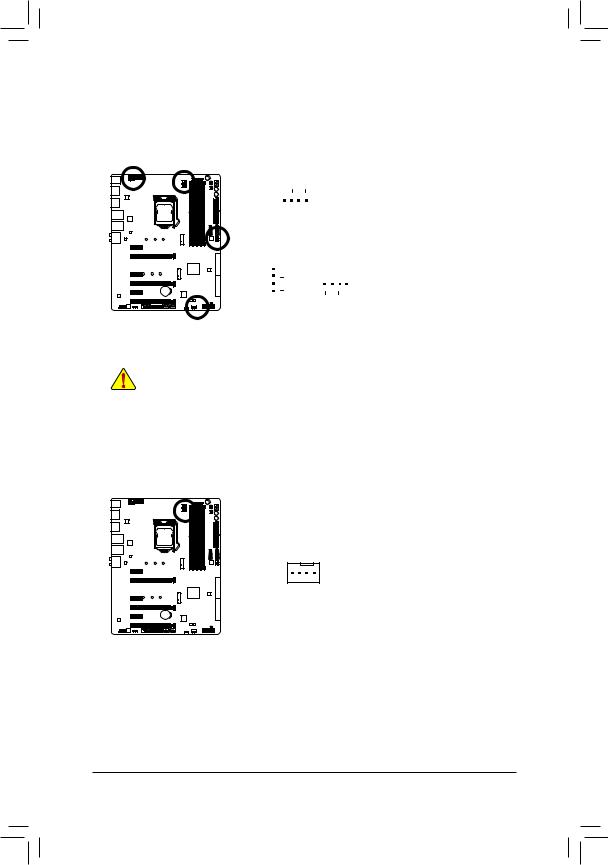
3/4) CPU_FAN/SYS_FAN1/2/3 (Fan Headers)
All fan headers on this motherboard are 4-pin. Most fan headers possess a foolproof insertion design. When connecting a fan cable, be sure to connect it in the correct orientation (the black connector wire is the ground wire). The speed control function requires the use of a fan with fan speed control design. For optimum heat dissipation, it is recommended that a system fan be installed inside the chassis.
|
|
|
|
|
|
|
|
|
|
|
CPU_FAN: |
|
|
|
|
|
|
|
|
1 |
|
|
|
|
Pin No. |
Definition |
|
|
|
|
|
|
|
|
|
|
|
1 |
GND |
||
|
|
|
|
|
|
|
|
|
|
|
|||
|
|
CPU_FAN |
|
|
|
|
|
|
|
||||
|
|
|
|
|
2 |
+12V |
|||||||
|
|
|
|
|
|
|
|
|
|
|
3 |
Sense |
|
|
|
|
|
|
|
|
|
|
|
|
4 |
Speed Control |
|
|
|
|
|
|
|
|
|
|
|
|
SYS_FAN1/2/3: |
||
|
|
|
|
|
|
|
|
|
|
|
|||
1 |
|
|
|
|
|
1 |
|
|
|
|
Pin No. |
Definition |
|
|
|
|
|
|
|
|
|
|
1 |
GND |
|||
|
|
|
|
|
|
|
|
|
|
||||
SYS_FAN2 |
|||||||||||||
SYS_FAN1/3 |
|
|
|||||||||||
2 |
Speed Control |
||||||||||||
|
|
|
|
|
|
|
|
|
|
|
3 |
Sense |
|
|
|
|
|
|
|
|
|
|
|
|
4 |
VCC |
|
•• Be sure to connect fan cables to the fan headers to prevent your CPU and system from overheating. Overheating may result in damage to the CPU or the system may hang.
•• Thesefanheadersarenotconfigurationjumperblocks.Donotplaceajumpercapontheheaders.
5)CPU_OPT (Water Cooling CPU Fan Header)
The fan header is 4-pin and possesses a foolproof insertion design. When connecting a fan cable, be sure to connect it in the correct orientation (the black connector wire is the ground wire). The speed control function requires the use of a fan with fan speed control design.
|
Pin No. |
Definition |
|
1 |
GND |
1 |
2 |
Speed Control |
|
3 |
Sense |
|
4 |
VCC |
Hardware Installation |
- 28 - |
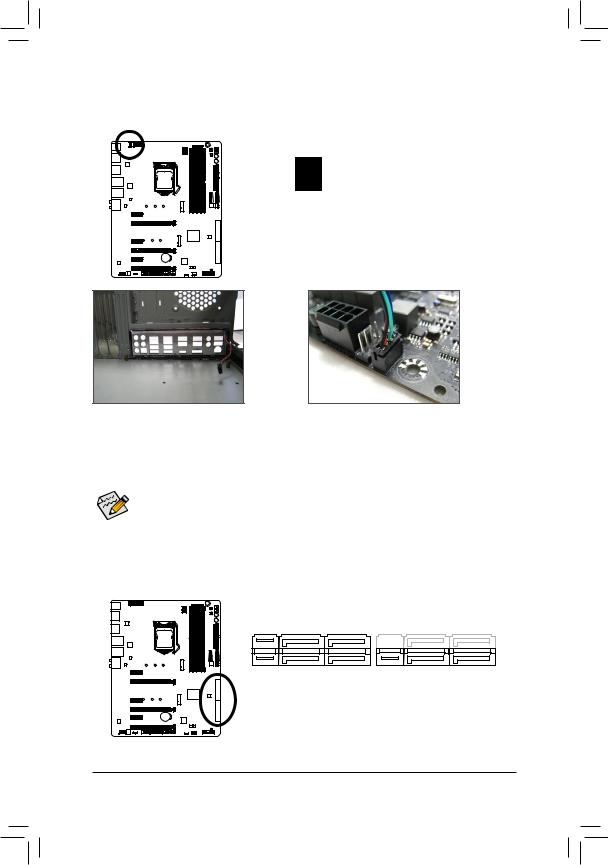
6)LED_IO (I/O Shield Audio LED Power Connector)
The power connector provides power to the LEDs on the I/O shield on the motherboard back panel.
1 |
|
|
|
|
|
|
|
Pin No. |
Definition |
|
|
|
1 |
+5V |
|
|
|
2 |
Red |
|
|
|||
|
|
|||
|
|
|
3 |
Green |
|
|
|
4 |
Blue |
Step 1:
Install the included I/O shield into the chassis. (For actual installation, please refer to the user guide for your chassis.)
Step 2:
Place the motherboard into the chassis, aligning the back panel connectors with the installed I/O shield. Connect the power cable from the I/O shield to the LED_IO connector on the motherboard.
For how to turn on/off the I/O shield LED indicators, refer to the instructions on in Chapter 2, "BIOS Setup," "Peripherals," or Chapter 5, "Unique Features," "APP Center\Ambient LED."
7)SATA EXPRESS (SATA Express Connectors)
Each SATA Express connector supports a single SATA Express device.
- 29 - |
Hardware Installation |
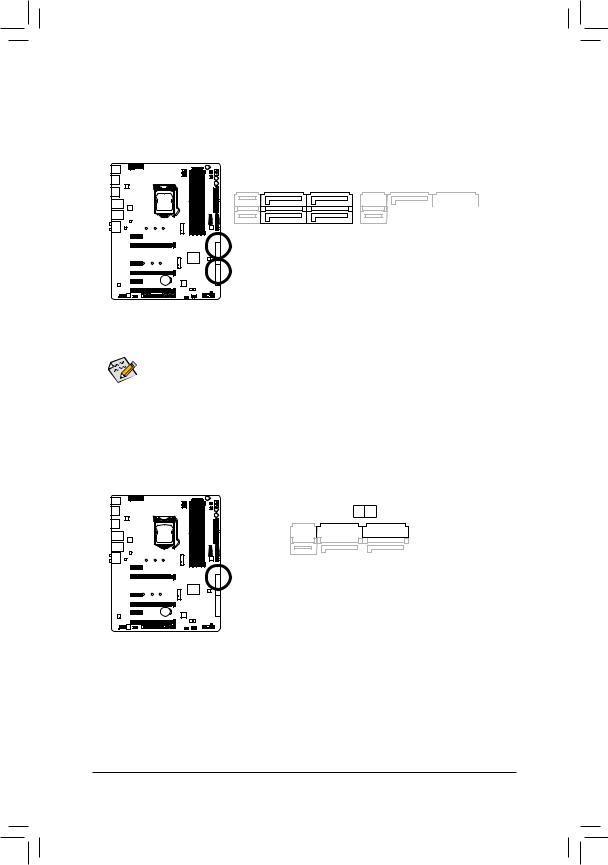
8)SATA3 0/1/2/3/4/5 (SATA 6Gb/s Connectors, Controlled by Intel® Z170 Chipset)
The SATA connectors conform to SATA 6Gb/s standard and are compatible with SATA 3Gb/s and SATA 1.5Gb/s standard. Each SATA connector supports a single SATA device. The Intel® ChipsetsupportsRAID0, RAID 1, RAID 5, and RAID 10. Refer to Chapter 3, "Configuring a RAID Set," for instructions on configuring a RAID array.
SATA3 |
5 |
|
4 |
|
|
|
|
|
SATA3 |
|
|
|
|
|
|
|
|
|
|
|
|
|
|
|
|
|
|
|
|
3 |
2 |
|
|||||||||
|
1 |
|
0 |
|
||||||||||||||||
7 |
|
|
|
|
|
|
|
|
|
|
|
|
|
|
|
|
1 |
|||
7 |
|
|
|
|
|
|
|
|
|
|
|
|
|
|
|
|
|
|
|
1 |
|
|
|
|
|
|
|
|
|
|
|
|
|
|
|
|
|
|
|
|
|
|
|
Pin No. |
Definition |
|||||||||||||||||
|
|
1 |
GND |
|
|
|
|
|
|
|
|
|
|
|
||||||
|
|
2 |
TXP |
|
|
|
|
|
|
|
|
|
|
|
||||||
|
|
3 |
TXN |
|
|
|
|
|
|
|
|
|
|
|
||||||
|
|
4 |
GND |
|
|
|
|
|
|
|
|
|
|
|
||||||
|
|
5 |
RXN |
|
|
|
|
|
|
|
|
|
|
|
||||||
|
|
6 |
RXP |
|
|
|
|
|
|
|
|
|
|
|
||||||
|
|
7 |
GND |
|
|
|
|
|
|
|
|
|
|
|
||||||
To enable hot-plugging for the SATA ports, refer to Chapter 2, "BIOS Setup," "Peripherals\SATA
Configuration," for more information.
9)SATA3 6/7 (SATA 6Gb/s Connectors, Controlled by ASMedia® ASM1061 Chip)
The SATA connectors conform to SATA 6Gb/s standard and are compatible with SATA 3Gb/s and SATA 1.5Gb/s standard. Each SATA connector supports a single SATA device.
SATA3 7 6
7 |
|
|
|
|
|
|
|
|
|
|
|
|
|
|
|
1 |
|||
7 |
|
|
|
|
|
|
|
|
|
|
|
|
|
|
|
|
|
|
1 |
|
|
|
|
|
|
|
|
|
|
|
|
|
|
|
|
|
|
|
|
|
|
|
|
|
|
|
|
|
|
|
|
|
|
|
|
|
|
|
|
|
|
Pin No. |
Definition |
||||||||||||||||
|
|
1 |
GND |
|
|
|
|
||||||||||||
|
|
2 |
TXP |
|
|
|
|
||||||||||||
|
|
3 |
TXN |
|
|
|
|
||||||||||||
|
|
4 |
GND |
|
|
|
|
||||||||||||
|
|
5 |
RXN |
|
|
|
|
||||||||||||
|
|
6 |
RXP |
|
|
|
|
||||||||||||
|
|
7 |
GND |
|
|
|
|
||||||||||||
Hardware Installation |
- 30 - |
